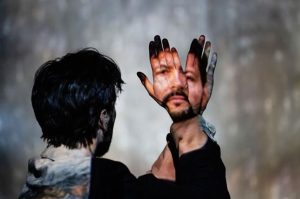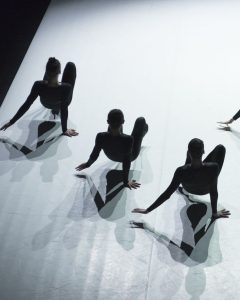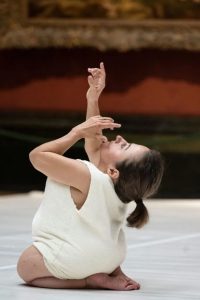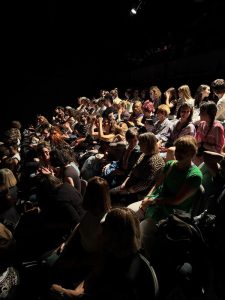Author: Emese Szabó.
The 41st edition of the Dance Week Festival in Zagreb, one of the oldest in Europe, took place in 2024. This year’s festival is asking questions such as: Who do we dance for? Who dances? Why do we dance? Whose dance is it? – as stated on the festival’s website. The five performances of the 41st year indeed touch upon these questions through their diversity. The artists came from different parts of Europe, each with a distinct cultural background, and in their performances they used a unique style of expression that set them apart from each other.
The festival opened with a solo performance titled Arms that never knew me. This piece was poetic, gentle – a well-chosen start to the festival. Since this performance specifically explored the boundaries between reality and imagination it felt as if we were entering into a shared, communal time. The creators (Milan Tomašik and Charlie Brittain) drew inspiration from Erin Manning’s philosophical approach, where movement is always on the edge of reality and metaphysics – „a quasi-virtual experience”. It’s real because all steps actually take place. Virtual, because the experience during movement carries not only the present moment, but also past and future experiences, thoughts, memories stored in the mind and body. Thus, it is virtual because it does not evoke the physical reality, but rather exists in the mental or emotional dimension.

Milan Tomašik and Charlie Brittain: Arms that never knew me. Photo by Darja Štravs Tisu.
The stage was empty, just a white, curtain-like element hanging from the back. It appeared to be made of thin plastic, spreading across the floor and was mostly illuminated with warm light – serving as a gateway to another dimension, the aforementioned “virtuality”. Milan Tomašik wore a white suit, matching the only element in the space. This not only added elegance but also interacted with the lights, making the white elements act as both a canvas and a screen. Tomašik’s movements ranged from flailing, tense, and forceful to soft, light, and airy. In one scene, a loud war siren blared, accompanied by screams, creating a disturbing and fear-inducing atmosphere as we sat in the audience.
In another scene, as he crossed the curtain for the first time into a very faint light, it was as if he returned as a different being, timeless. He lay down, lifted his bare upper body, and moved as if floating in water. This faint lighting created the illusion that he wasn’t even touching the ground – gentle and poetic.
Throughout the performance, a few text excerpts were recited, one of them reflecting on the awareness of the performer’s own body. This monologue prompted the audience to scan their own bodies, their breath, and their contours.
The highlight of the performance was when reality and virtuality intersected: Tomašik first projected a full-body image of himself onto the white curtain, then stood within this image, using himself as a canvas – a meta-moment. As he moved, his self-portrait appeared on his palm, back, and arms. During the performance Tomašik played with the concept of existence, continuous transformation, and renewal. The white curtain suggested that here was an opportunity for transformation, for metamorphosis; one could hide within it and emerge transformed. The quality of movements varied from scene to scene, alternating between sharp, bold gestures and those reminiscent of floating. With his moving concept, he created a uniqe spatial and temporal experience for the audience.
Just as Tomašik has developed his unique movement method, named Poetic Body, Rafaële Giovanola also developed hers. She advertised a workshop under the title Untaught Body, where dance and movement take center stage, birthing dramaturgy and thought. This experimental approach was evident in the performance Vis Motrix, choreographed by Rafaële Giovanola. I recommend checking out the CocoonDance MoveApp (developed by Giovanola and the Cocoon Dance Company) which is based on a movement glossary, allowing users to learn and try dance-related concepts themselves.

Rafaële Giovanola: Vis Motrix. Photo by Klaus Fröhlich.
A fun fact shared by Giovanola after the Vis Motrix performance was that she had often heard that audience members tried out the unusual body posture and walk used by the dancers in the performance at home. Specifically, a reverse tabletop pose. This movement was indeed so unusual and mesmerizing that it’s no wonder the audience wanted to experience this otherness with their own bodies.
The creature-like performers truly appeared like aliens, sometimes enormous insects. This effect was achieved not only through posture but also with the tight black costumes, facial expressions, and lighting. Their shadows became an integral part of their movement, sometimes doubling their bodies and creating an even more surreal sight. These beings never stood up on two legs. They moved in a constant, tense, rhythmic walk. Everything natural started to become strange in this world – for example, blinking almost disrupted this illusion as it was the only everyday “movement” they performed – raising the question: What is natural in movement, body, and in humans?
On the third day we traveled to Rijeka, to see a performance which is part of the Festival of Inclusion as a long-time partner of the Dance Week Festival. The venue we arrived at was celebrating the opening of an exhibition on the ground floor titled The Otherness. Meanwhile, people in wheelchairs queued for the lift to get to the performance upstairs. This process was slow due to the extremely slow ramp, and the upper space was hot and not suitable for waiting. This place is awarded by the city to the community for being inclusive, but this situation with the ramp immediately raised questions about care, inclusion, acceptance, and adaptation in me.

Chiara Bersani: Gentle Unicorn. Photo by Foteini Christofilopoulou.
The performer Chiara Bersani is 98 cm tall. She laid on a white ballet floor surrounded by seated spectators. We were viewers, voyeurs. During The Gentle Unicorn, we had time for introspection. Her movements were slow and exploratory. She used a minimalist dramaturgy, the emphasis was not on a multitude of actions but rather on observation. She yawned several times, laughed, crawled on the floor, and exposed her body to our gaze. She declared this space as one where we could stare, get used to her, interpret, and frame a different kind of body. In the description of the performance, Chiara Bersani states: You are not the one interpreting me; I will show you how to understand me. She did this by stopping occasionally while crawling, getting very close to her viewers, touching them, leaning on them, and leaving it up to us to react to this contact. At the end of the performance, out-of-tune brass instruments played from the dark by some members of the audience, more exactly from the community. Indeed, it became evident even before the performance began that a significant portion of the audience are related to the community of people with disabilites. And Chiara Bersani blew a trumpet. This was their manifesto: we are here, and we want our voices to be heard.
Staying with the questions posed by the festival, the performance Gentle Unicorn most strongly explores the query, Whose dance is it? Through her own movements the performer deconstructs the notion of dance as belonging to geniuses or the privileged we can only long for. Bersani showcases the diversity of the body and movement. As she wrote it in the description: she declares herself a unicorn, reinterpreting and reframing this oft-used symbol. We, as the audience, bear witness to this transformation.
And why do we dance after all? This question was posed by the Tangaj Collective in Choreomaniacs. The performance narrated a story from 1518 in Strasbourg when a dance epidemic broke out in the city’s central square, where tons of people started dancing and they were unable to stop. On stage were five dancers, with no indication of the medieval period, the characters recalled this story from a contemporary perspective. The performance was text-based, but unfortunately, the text was often hard to understand. The Romanian actors spoke English into microphones, sometimes with an accent or not articulate enough. Although there was an effort to inject humor, the jokes rarely landed with the audience. Despite this, the performance raised questions: Why do we dance? Why do we watch dance? First, the story itself is astonishing. Imagine masses of people dancing uncontrollably in the Middle Ages, falling into a trance-like state. Quarantines are declared, the church views it as a supernatural phenomenon, and many believe it to be harmful. Secondly, since this is a movement performance, it allows us to view ourselves from an external perspective: essentially, what is this tradition where we observe movement forms that are difficult to rationally interpret and believe they express something about us?
Just as the first performance, Arms that never knew me, was a well-chosen opening because of its special time- and space creating effect, the last performance, The Future and Ancestor by Sine Qua Non Art Company, functioned well as a festival closer. Its uniqueness lay in disrupting our traditional role as spectators. There were no seats; we could move freely among the three performers who moved around us. Strange, intimidating beings – three naked men, their bodies largely covered in colorful glitter, their faces obscured – created an eerie and unknown feeling. They lay on concrete blocks, and when they stood, we saw the imprints of the blocks on their skin. They carried these blocks around us, lifting them high, which was unsettling and dangerous, requiring us to trust them. This was not easy; some audience members stepped aside to avoid interaction when the dancers approached. The music was ominous, and only a few neon lights illuminating the dark space.
As they started to sweat, the glitter fell off, leaving them completely naked. They then tied the concrete blocks to their feet like cothurni, connecting with each other through this encumbered walk. The concrete blocks evoked our built environment, the weight of urbanity and its alienation. But this aspect wasn’t the most important; rather, it was the sensations their approach caused – the aforementioned fear of the unknown and the question of trust. The performance became a true event, happening together with the spectators and it affected us greatly.

Audience of the Dance Week Festival in Zagreb.
Through the questions discussed above, the festival aimed to embody sustainability, as they described it. Sustainability can be decoded in various ways: on one hand, it could refer to the festival’s ability to occur year after year, which is increasingly challenging. During my visit to Croatia, I spoke with many professionals in the dance field who mentioned the difficulties they face in organizing events: lack of support, resources, and audience. Yet, 41 consecutive years is a long time, and this is encouraging. So this could mean economic sustainability. On the other hand, it could also refer to social and artistic sustainability, such as creating more inclusive programs, strengthening relationships with partner countries, and inviting innovative performances that have a deep and lasting impact. We hope there will be a 42nd edition.
This text was written by Emese Szabó within the framework of the Beyond Front@: Bridging Periphery project.

